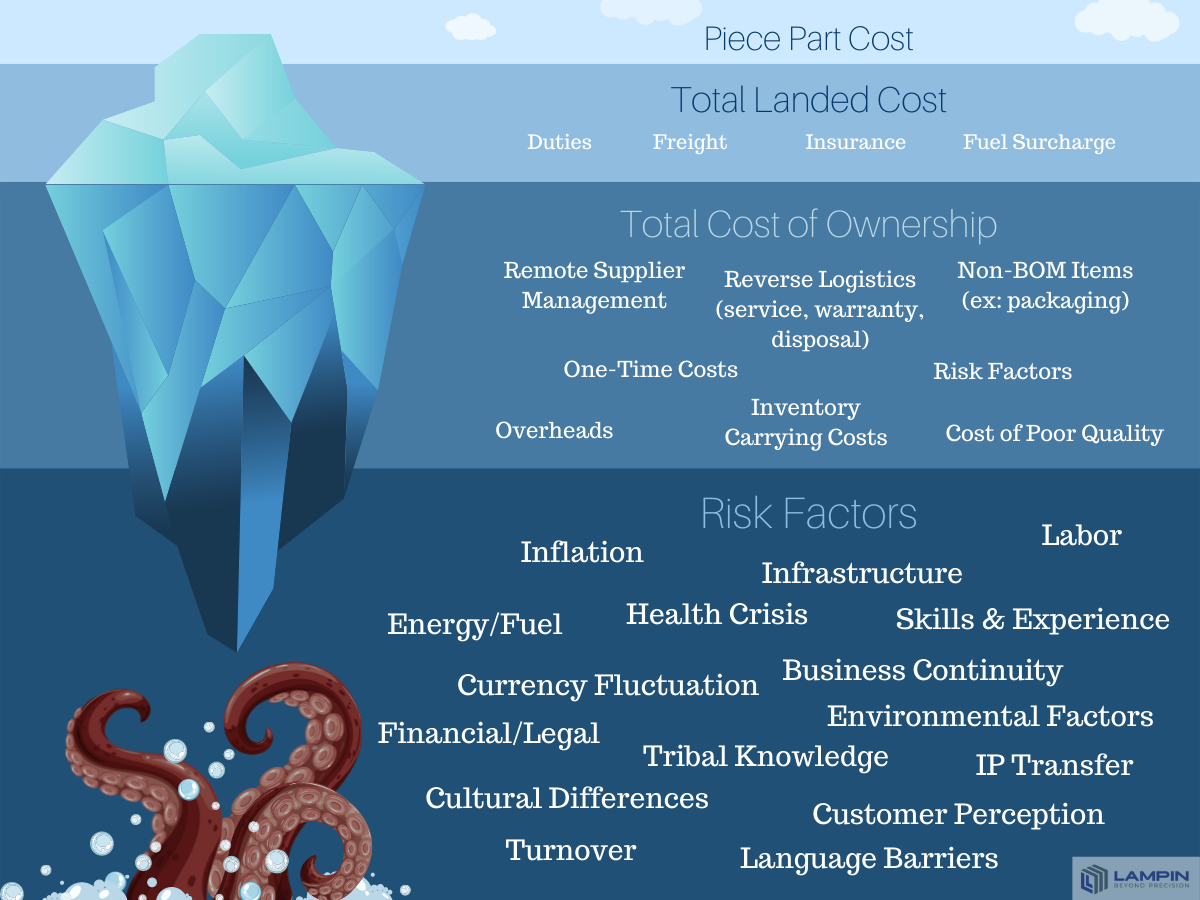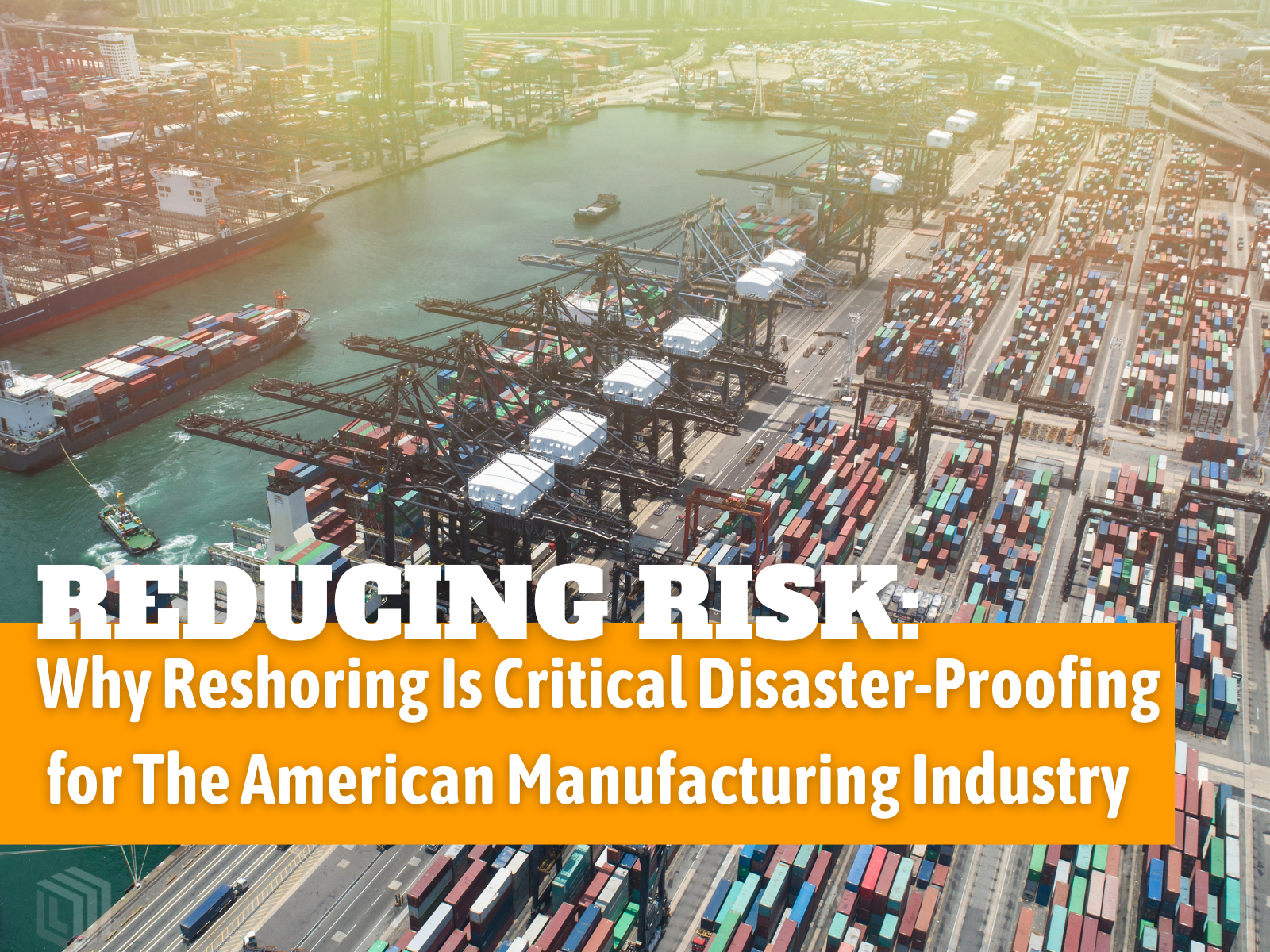Reshoring doesn’t just mean bringing work to the US— it means bringing work close to home, and it may be the key to saving an industry flanked by challenges from every side.
by John Biagioni
June 29, 2022
In 2013 I published an article on reshoring and the strategic reasoning that was driving a growing number of companies toward a “build where you sell” mindset. At the time, it was one of Industry Week’s most-read articles of the year. Readers were receptive, sharing some bad experiences that pushed them to agree and, in some cases, even considering strategic operational changes. But, for the most part, the predictions in the article were hypothetical.
The expansive nature of the model was necessary to show multiple dimensions of risk and how they played into one another. Not in my wildest dreams did I imagine that all of the risk factors I had first identified would come into play. Scenarios where multiple risk factors would affect the supply chain simultaneously didn’t even begin to cross my mind. Then COVID-19 pandemic hit.
The exponential nature of compounding risk factors
The pandemic brought the risks of global supply chains into stark relief. Companies that have relied almost entirely on foreign suppliers for critical components were forced to scramble to find alternative sources of supply. In many cases, trying to mitigate the risk of disruptions by diversifying your supplier base is a good start, but it’s not enough. The pandemic has shown us that we need to rethink our approach to global supply chains. We can no longer afford to put all of our eggs in one basket.
The good news is that there are things we can do to mitigate the risks associated with global supply chains. One way to do this is by changing the way we look at total cost of ownership (TCO). These calculations take into account the costs associated with sourcing from a particular supplier, including transportation, storage, and insurance costs. What they don’t always account for is the exponential impact of a compound risk scenario.
Beginning in early 2020 we witnessed an unprecedented combination of industry-disrupting factors. We collectively watched the cascade play out in real time: a global health crisis that drastically limited labor, a freeze on international shipping, currency fluctuations, cargo and transportation depletion, materials shortages, and so on.
Hidden risks your TCO analysis probably missed

You think you’ve considered your hidden risk factors, but what do you do when something else comes along to amplify the problem?
In light of the pandemic, we need to start looking at TCO models that take into account the risk of multiple, simultaneous disruptions. One way to do this is by using a Monte Carlo simulation. This type of simulation takes into account the probability of different events occurring and the impact that they would have on the supply chain. By running multiple simulations, companies can get a better sense of the risks associated with their supplier base and make more informed decisions about where to source their products.
Additionally, companies must consider the soft factors– factors that are challenging to track via ERP but have a notable impact on the true cost; communication challenges, time differences, production delays, and IP protection problems all become amplified relative to distance.
Not all of us have the resources to develop complex models or run the simulations needed to develop a personalized risk analysis. An expanded TCO assessment brings to light the wisdom in the old adage, “build where you sell.”
In this new world of exponential risk, where what was once hypothetical is now a reality, we need to take a closer look at our supply chains and rethink the way we do business. One simple way to reduce risk is to build up a robust domestic supplier base to ensure that you have the capacity to meet customer demand even if there are disruptions in your supply chain. When companies source products from multiple suppliers in different countries, they are effectively hedging their bets against disruptions. This approach is not without its own risks, but it is a more effective way to mitigate the risk of disruptions than relying on a single supplier.
Asking the right questions is key when it comes to evaluating intersecting risks
Of course, this isn’t always possible or practical. In some cases, it may make more sense to source from a foreign supplier because they have the expertise or capacity that you need. In these cases, it’s important to have a clear understanding of the ‘worst-case scenario’ that intersecting risk could introduce, and a strong contingency plan in place in case of a disruption.
Maintaining a strong relationship with domestic vendors and service providers close to your area of demand means that supply lines remain active. Additionally, you can use technology to your advantage by investing in digital tools that help you manage your supply chain, such as enterprise resource planning (ERP) systems, supply chain management (SCM) software, and transportation management systems (TMS).
Based on where we all sit today, I would broaden the review beyond the original risk factors and develop mitigation strategies based on the materiality of those risks. Expansion of the TCO model could include environmental, social, and governance (ESG) aspects of where you build and also how your suppliers build and source from. The fact is, your TCO model should be expanding to keep pace with the reality of the global manufacturing community’s expanding complexities.
Consider re-evaluating the binary decision-making structure of choosing to build either here or there; instead, consider how risk could be reduced with a split ratio build. What would it look like to build 30% here and 70% there? A supplier/partner located in close proximity to demand that could operate as a pilot facility for product launches, for ECO cutovers, for any reason where speed of response is a critical factor.
We need to think about how we can use our local advantage to build market share even as we maintain a lean cost structure. The companies that will succeed in the emerging manufacturing landscape will be the ones that can figure out how to do both. These domestic sources might only represent 20-30% of all the demand but would be the first line of defense in terms of capacity issues or other listed risks where it could act as a decoupler.
Be decisive, but reassess your supply chain often
To be decisive, you must be well-informed. Your decisions do not need to be precise, they need to be directionally correct and open to review so you understand whether the input assumptions are living up to your projections. You should always be able to point back to why a decision was made, and that decision should always have a well-thought framework that becomes the artifact of your decision. When the factors impacting your decision change, it’s time to reassess and realign in accordance with the reality you’re facing.
A great example of the way a proactive approach to complex risk mitigation can aid in rapid recovery is the story of Western Digital’s response to sudden flooding in Thailand. Following catastrophic floods that took nearby neighbors like Honda nearly 6 months of recovery and cleanup, Western Digital was operational in a remarkable 46 days thanks to a broad spectrum of risk analysis, preparation, and amelioration planning. However, as a major supplier of hard drives to almost 40,000 companies globally, this example stands out as a ‘near miss’ and reminds us that our suppliers’ weaknesses also become our own once they are enmeshed in our critical supply chain.
Lampin can help you reduce risk in your supply chain
A local, mid-tier supplier like Lampin can act as the flexible element in your supply chain, providing a cushion to absorb some of the risk. By sourcing a certain portion of your supply from a local manufacturing partner you are effectively decoupling multiple risk vectors and improving your likelihood of continuity through challenging times.
As an ESOP, Lampin can also be very competitive because we are highly motivated to reinvest in these processes. If we don’t have the means to satisfy Cpk for a certain customer we can seek out the equipment to make it happen. This means that we are constantly improving our capabilities and ability to offer our clients more accurate tolerances, faster turnaround times, and higher quality products while helping them reduce risk and TCO.
While there is no single silver bullet that will protect us from the risks associated with global supply chains, we can take steps to mitigate these risks. By changing the way we look at TCO models and incorporating a more holistic risk profile into our decision-making process, we can make our supply chains more resilient and better equipped to weather the next storm.
Did this article make you reconsider the hidden risks in your production sequence?
If you’re looking for a partner that can reduce risk in your supply chain, Lampin is here to help. We have the experience and capabilities to provide a cushion against potential disruptions, ensuring continuity of supply for your business.


